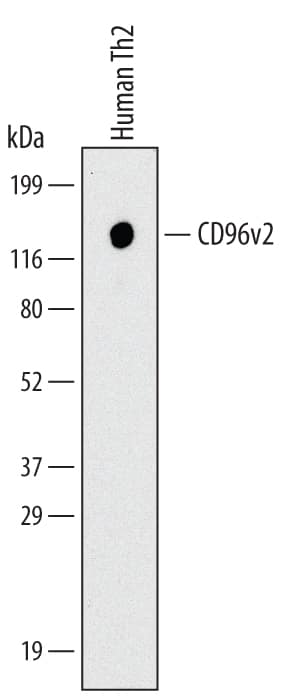Human CD96v2 Antibody
R&D Systems, part of Bio-Techne | Catalog # MAB61991

Key Product Details
Species Reactivity
Applications
Label
Antibody Source
Product Specifications
Immunogen
Lys25-Asp501
Accession # NP_005807
Specificity
Clonality
Host
Isotype
Scientific Data Images for Human CD96v2 Antibody
Detection of Human CD96v2 by Western Blot.
Western blot shows lysates of human Th2 cells. PVDF Membrane was probed with 2 µg/mL of Mouse Anti-Human CD96v2 Monoclonal Antibody (Catalog # MAB61991) followed by HRP-conjugated Anti-Mouse IgG Secondary Antibody (Catalog # HAF007). A specific band was detected for CD96v2 at approximately 130 kDa (as indicated). This experiment was conducted under non-reducing conditions and using Immunoblot Buffer Group 1.Applications for Human CD96v2 Antibody
Western Blot
Sample: Human Th2 cells under non-reducing conditions only
Formulation, Preparation, and Storage
Purification
Reconstitution
Formulation
Shipping
Stability & Storage
- 12 months from date of receipt, -20 to -70 °C as supplied.
- 1 month, 2 to 8 °C under sterile conditions after reconstitution.
- 6 months, -20 to -70 °C under sterile conditions after reconstitution.
Background: CD96
CD96 (also known as Tactile) is an approximately 160 kDa type I transmembrane glycoprotein that contains three Ig-like domains in its extracellular region. It is expressed on CD4+ and CD8+ T cells, NK cells, and select B cells. CD96 binds to CD155/PVR and participates in NK cell-mediated lysis of CD155+ target cells. Alternate splicing generates a short variant (CD96v2) which lacks 16 amino acids (aa) within the second Ig-like domain. CD96v2 is the predominant isoform in many cell types and exhibits even greater binding affinity with CD155 than does full length CD96. A soluble form of CD96 circulates in the serum. Over aa 22-501, human CD96v2 shares 55% aa sequence identity with mouse and rat CD96.
Alternate Names
Gene Symbol
UniProt
Additional CD96 Products
Product Documents for Human CD96v2 Antibody
Product Specific Notices for Human CD96v2 Antibody
For research use only
